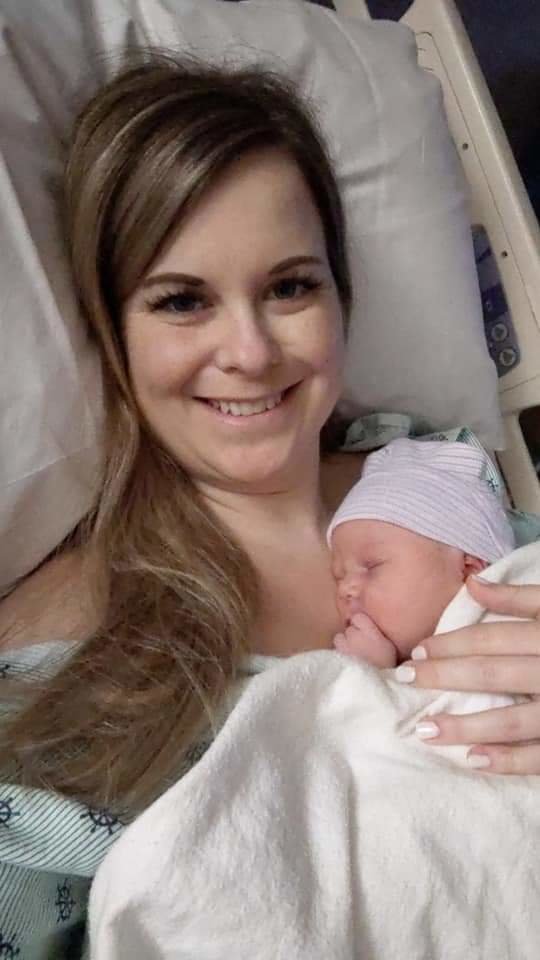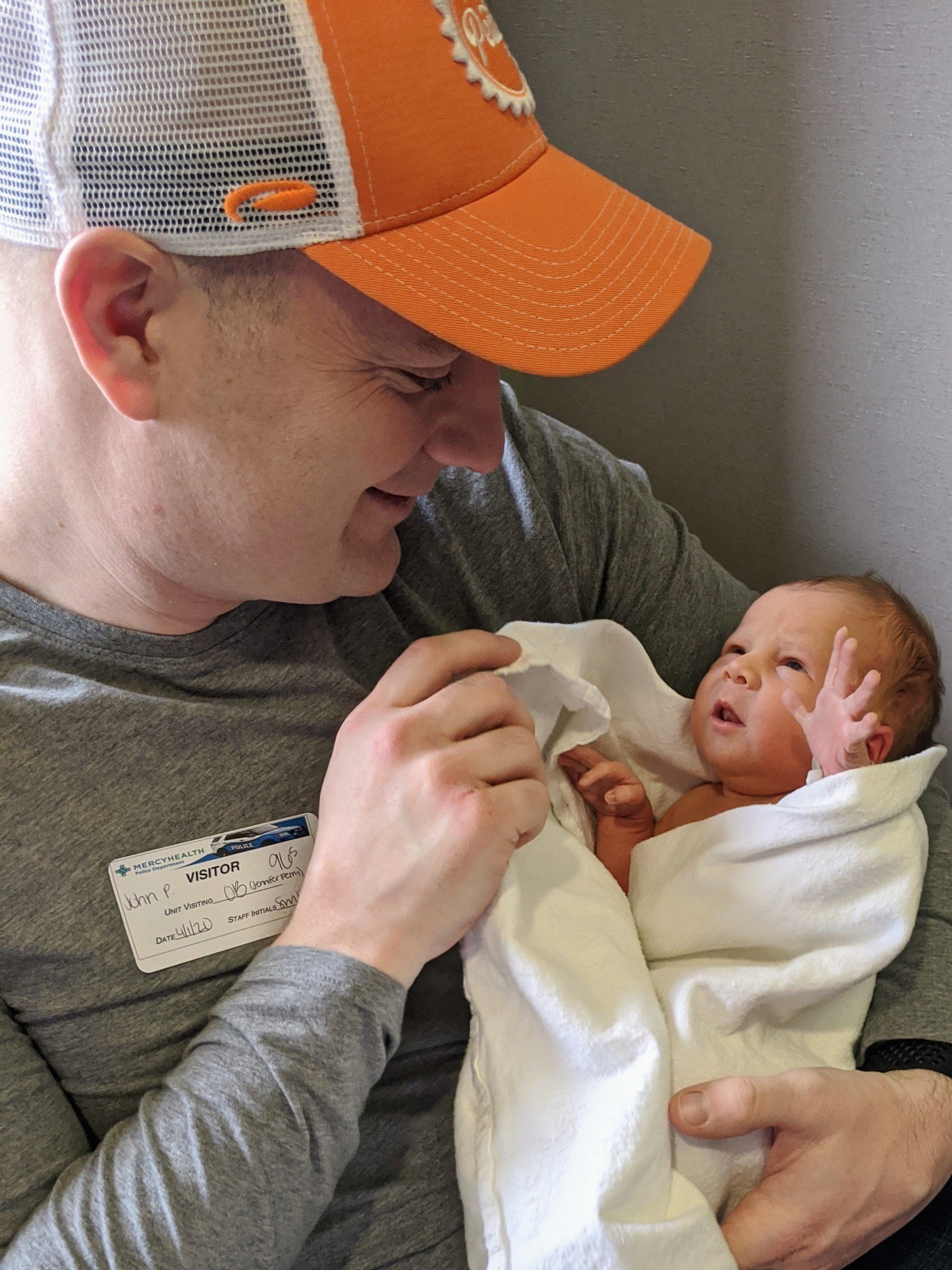
Jennifer Perry of Tiffin, Ohio, was working as a physician's assistant when the coronavirus pandemic started to erupt across the US. As a health care professional, Perry was concerned about being able to treat incoming COVID-19 patients with an increasingly low amount of personal protective equipment — gloves, masks, and other protective gear health care workers use — and few testing kits. As a woman nine months into her pregnancy, Perry was worried about catching the dreaded virus herself. Now, Perry is speaking with CafeMom about what it was like to give birth during the pandemic — and be told that her husband couldn't be in the room with her after all.
Perry tells us she was working in urgent care when the coronavirus hit the US.

She remembers how after the first few cases started to pop up in early March, there was an influx of people asking for testing.
"Obviously, that wasn't available," she says. "Depending on their symptoms, we could offer them a flu swab and/or strep swab at least to rule those out as possibilities, but there was nothing we could do to confirm whether it was COVID-19 or not."
It was a confusing time, as it wasn't even clear where to send patients who were seeking coronavirus testing.
"The health department didn't have them, doctor's office didn't have them, we didn't want to overwhelm the emergency room by sending stable/non-emergent patients who simply needed a test … It was really frustrating," she says.
That wasn't the only thing causing Perry some stress. Her baby's due date was also coming.
With a near 2-year-old son, Maximus, at home and at nine months pregnant, Perry felt that that whole thing was "anxiety-provoking."
"We didn't have PPE aside from gloves — no masks or face shields or gowns," she continues. "And when you perform a flu swab or a strep swab, you have to get really close to the patient and performing the test often makes them cough right in your face."
After each shift, Perry and her husband would weigh the risk of the mom getting exposed.
Because so little was known about the virus — how it was spread, what the symptoms were, how dangerous was it — it was easy to feel overwhelmed by what was happening.
"When the data started looking more serious, we decided that the risk was just too great," she recalls. "Especially since I already had some other high risk complications in my pregnancy."
So Perry decided not to return to work for the last two weeks before her due date. She left for maternity leave on March 13, ahead of her planned schedule, but it felt like a necessary step.
A week and a half later, Ohio Gov. Mike DeWine declared a stay-at-home order for the state.

Eventually, the owner of the urgent care where Perry worked decided to shut down indefinitely.
"We aren't sure if or when he will decide to reopen," she says.
Suddenly, Perry and her family were starting to show signs of COVID-19. On March 18, the signs started off as mild. But days later, by March 21, "I felt like I got hit by a bus."
"My husband and I could barely get off the couch," she recalls. "We were so exhausted. Achy all over. I was having fevers. And I had a nasty cough."
It wasn't easy for the mom to get tested.
The closest place Perry could get tested was 45 minutes away, and neither Perry's husband, nor Maximus, could get swabbed "because testing was still so limited at that point."
Perry was given the go-ahead, because she was so close to her due date and she had the worst symptoms of the three. And she wouldn't receive her results quickly — in fact, she wouldn't get them until 11 days later.
Meanwhile, over the next two weeks, her birth plan kept changing in response to the pandemic.
"At one point, our hospital put in a restriction that you could only have one visitor, which didn't include the doula that we had hired and been working with throughout the pregnancy," she says. "Then, a few days later they adjusted the rules, and the doula was allowed."
Finally, her water broke on March 30.
She called her obstetrician to let them know that she was on her way, but was told that there was going to be a problem: Her husband wasn't allowed in the delivery room.
"Since my test results weren't back yet, and I wasn't seven days symptom-free, they had to treat me as if I was positive for COVID-19," she explains. "At that point, the rule was if you're COVID-positive, you couldn't have any visitors — not even your spouse or a doula."
"It was a horrible feeling," she remembers. "We hadn't prepared for that possibility."
Perry describes it felt like someone pulled the rug out from underneath the two of them.
"I already was bummed out that our family wouldn't be able to be there in the waiting room, like with the birth of my son," she says. "But then to be told that Jon couldn't be there was just devastating."
They tried everything to avoid Perry having to give birth without her husband — calling every hospital within a few hour radius to see if they had different rules "and if we delivered there if my husband could join me."
"A lot of the hospitals didn't even have protocols in place or weren't sure what they were," she says. "But the ones that did had the same rules as our local hospital so we ended up delivering [at Mercy Tiffin hospital] as planned."
Her husband dropped her off at the hospital at around 2 p.m.
As she explained in a post on Facebook from April 6, Perry wrote that she was "given a mask and whisked through the halls … feeling like a ticking time bomb."
There were few supplies "because anything in there would be considered contaminated whether we used it or not." And a nurse had to remain with Perry the entire time she was in labor "because if something were to turn south with me or the baby there might not be time for the nurse to reapply all her protective gear quickly enough to attend to our needs." Luckily, the first nurse on duty was a friend of Perry's "but she also wasn’t my husband. I wasn’t supposed to be doing this without him."
In total, Perry labored for 12 hours.
She tells us that she already had a high-risk pregnancy to begin with "and then ran into additional complications during labor and delivery."
Twelve hours later, on what was technically midnight on March 31, and with no epidural or pain medications, Perry finally ended up having a C-section. Throughout the day, she and her husband spoke on the phone and video chatted.
"It was definitely better than nothing," she admits. "I felt grateful that he could be included and help support me, but it was no replacement for the real thing."
Perry was even able to video chat her husband during her C-section.

And although her husband couldn't be in the room when it happened, he was there to learn that his wife had just had a baby girl via video chat.
"It was honestly a magical moment," she says. "But just as quickly, the magic was gone and we had to hang up and I had to go back to my room without a husband to greet me and meet our daughter in person."
The next morning, on April 1, Perry had her second bit of happy news — she tested negative for coronavirus.
"At that point we got the go ahead that he could come up and see me and meet the baby for the first time," she recalls.
On April 2, Perry was officially discharged from the hospital.

Her newborn, Elliette Nicole, never showed any signs of the coronavirus and Perry tells us she is home and healing well from her C-section.
Perry is lucky to have come through her ordeal in good health. Her advice for anyone who is pregnant and concerned about COVID-19? Take care to limit your exposure to the virus.
"Be gentle with yourself if you are more anxious or worried than usual — these are unprecedented times," she adds. "Stand firm in whatever decisions you make to protect yourself and your baby, even if they're unpopular with your family or friends. Plan for and control the few things that you can, and try your best to let go of the rest."
Perry hopes that by sharing her story, she can help other women who are worried about giving birth without a spouse.
"I wanted to let them know that if I could do it, then they can do it too," she says. "Yeah, it was a tough day, and it was really difficult to not be able to share that experience with my husband. But it was also really empowering."
And she reiterates that it's important for everyone to observe healthcare guidelines in regards to the coronavirus.
"These are critical to protecting not only the high-risk members of our society but also the brave health care providers who are working the front lines during this crisis," she says. And in the end, it was all worth it to keep herself and others safe.
Perry concludes, "I had to deliver my baby alone, and I would do it again in a heartbeat."




